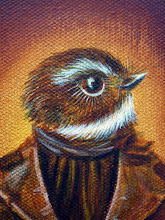,

Even though I have started back at the studio (well, my garage), I feel wonderfully refreshed after a break out of Auckland. Friends of mine live up North near Waimamaku and I was fortunate to spend New Year's with them. Staying so near the Waipoua Forest, there was much in the way of bird life and native flora to see. Even though I got a much needed break away, my brain was still inspired and ticking over.

On the way up I had to stop off and visit the Four Sisters and Te Matua Ngahere to pay my respects. It was so nice to be able to get some fresh air and stretch my legs as well as being reminded of how magnificent our Kauri are. It was like visiting a giant outdoor cathedral with that same sense of peace and grandeur. Some paintings exploring Kauri might have to occur.

The Waipoua Forest is home to many native birds, endangered including kiwi and kokako. I hope to do a mission to view and hear some of the northland kokako during the year. What is particularly interesting is that the call of the kokako has regional differences. Apparently this can cause problems in transferring birds from one sanctuary to another, they don't respond to calls that they don't recognise. DOC and researchers have counteracted that problem with exposing birds to regional calls at a young age to assist with their translocation.

New Year's day saw me paying for the previous evening's festivities by going for a mountain bike ride. I managed to see a native orchid that I had never seen before growing on the side of the road. I must look it up really, to find out what it is, unfortunately I didn't have my camera on me. Our native orchids are just delightful. I didn't quite have enough steam to make it to the cafe for coffee and cake, or rather I didn't think that I would make it back.

The next day was spent swimming and lazing in the sun on Waimamaku beach. It is just beautiful out there regardless of the weather. The tranquility of the river as it meanders towards the coast is in stark contrast to the ruggedness of the water, like how you get at all West Coast beaches. When I went for a walk, with my camera this time, I managed to get some neat photos of kawau, I'm not sure which kind, it was two parents and a juvenile, I think. They were quite annoyed with me following them, actually I was just heading back in the same direction. The first photo is capturing them getting startled by a wave, as I was busy laughing at them, I got saturated also. Karma. The second one is further down the beach, I am unsure if it is of the same family group. I think that I will have to do some works based on these guys at some point too.
 Harakeke Korimako
Harakeke Korimako

























